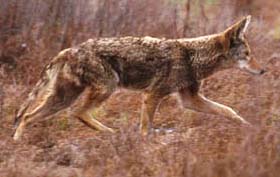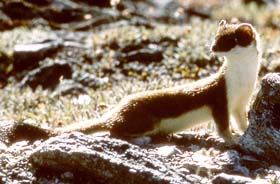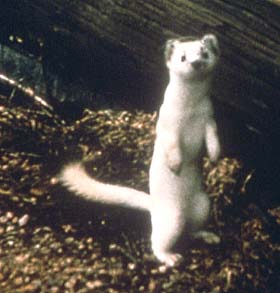 |
Coyote |
Image credit: US Fish and Wildlife Service |
 |
Short-Tailed Weasel |
 |
Ermine (Short-Tailed Weasel with Winter Coat) |
One thing we did, especially the first several years we were there on our place in Alberta, was trap animals whose fur had a market value. The main ones were coyote, badger, weasel (or when they were trapped in the winter, ermine). It was very profitable, but in the case of ermine and especially coyote, it had a double benefit because they were pests for chickens and turkeys. Irvine did nearly all the trapping as far as fur-bearing animals were concerned. My trapping, snaring, drowning out, and any other way of destroying pests was almost entirely limited to gophers. Getting back to the weasels or ermine, they are brown in the summer and white in the winter. They have a black tip on the end of their tail, almost an inch long, which remains the same year-round. They are about 13 or 14 inches long, including the tail, which is about five or six inches long. They have slim, lithe bodies. While they are about the same size [in volume] as the gophers, the gophers are heavier set and considerably shorter. While we would catch a gopher by hand, we would not think of trying to catch a weasel that way. It is a much fiercer animal.
One amusing incident involving a weasel happened when I ran across one apparently migrating to a new location. I chased him and he ran down a gopher hole, but appeared to be anxious to get on his way, as he kept coming to the opening as I waited. If I stayed motionless, he would creep farther out until I would move a little and he would dart back down the hole, but would reappear almost immediately. Soon I held my hand about eight inches straight above the hole and he would stretch out to within two or three inches of my hand until I moved it. There was a pebble nearby
so I picked it up and held it where my hand had been. Again he stretched out to within two or three inches of my hand, so this time I dropped the pebble on his nose. He went down so fast he rattled down the hole. Though I waited several minutes, he never showed again.
In the spring when the snow had been melted for about two or three weeks and the water collected on the ponds, there was a grass that grew up quickly through the water and floated on the top of it. It had very little substance but cattle loved it after being on dry feed all winter. It gave them
and [manure] collected on the lower part of their tails [forming a ball that] would get about 6 or 7 inches in diameter. This was usually no great problem. Ed and I would milk a cow apiece morning and evening and one evening his cow would not stand still. He followed the usual procedure and gave her a punch in the belly. She did not move but showed her displeasure by giving her tail a flick. Splat! The side of Ed's face instantly turned from white to green.
From time to time we would visit back and forth with neighbor children, boys and girls, [and] also would walk back and forth to and from school, [with] little thought of who we were with or by, not pairing off, just usually having a good time—a little teasing, a little scaring, etc, etc. One day our sister Anna had two girls over for company and they kept to themselves. We boys never gave it much thought and were doing things by ourselves, neither trying to join them nor avoiding them. Eventually we did approach near to where they were and were very much surprised to find them very hostile, both to our surprise and to our sister's surprise as well. One of them grabbed a pitchfork and drove us off. We did not understand the hostility. It had to be their fear or hostility or misunderstanding. They may have misunderstood something we had done but I rather think it was part of their upbringing that gave them their fear, [or something] they had experienced. We had not met them before, nor did we ever see them again.
He was a very unusual cat in that he roamed over quite a large area instead of staying mostly at home. He would be gone several days at a time and occasionally be gone two or three weeks at a time. When he did this we usually would figure he had died but usually he would show up, even in the winter when it was probably 30° to 40° below zero. In the spring his being gone a few days was no surprise but in the winter? One winter he was gone which was not unusual but in fact we were a little surprised he was back so soon. Something was different. He walked differently even though he limped very little. Upon examination we found he had been caught in a trap, caught only by the tips of his toes. A few days later a neighbor told us he had set a trap for a weasel. A day or two later he found the cat in his trap. Usually an animal caught in a trap fights the trap and dies before very long, especially in below zero weather. Apparently he fought it very little. [Instead, he] curled up, the snow drifted over him, and he rested until he was freed—how long we are not sure but probably most of a day at the least.
We had other cats around the place but they usually stayed in the shelter of the barn, very often sleeping on the horses' rumps. Even if we were late getting up and the cats were gone they left evidence that they had been there all night—a place on the horses' rumps where there was no frost. I do not remember that Frisk ever slept on the horses' rumps.
One thing we learned (or did we learn it?) on arriving in Alberta was that we should try not to get our hands and legs wet and then run around in very dry wind. To do so would be asking for a lot of suffering. When we were quite young that happened to us many times. Our hands and legs got badly chapped many, many times under these circumstances. As soon as it got warm enough in the spring we would go barefoot and in knee pants. It would be unthinkable to stay out of the water that collected from the melting snow—until the dry wind chapped our skin and then it would be too late.




